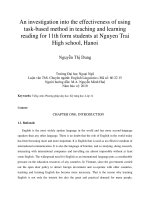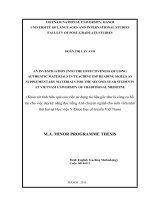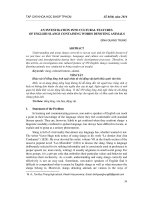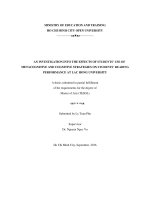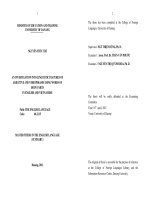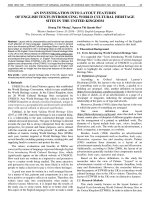An investigation into the effects of using the digital homework activities (dha) app on childrens learning of english vocabulary
Bạn đang xem bản rút gọn của tài liệu. Xem và tải ngay bản đầy đủ của tài liệu tại đây (1.24 MB, 88 trang )
MINISTRY OF EDUCATION AND TRAINING
QUY NHON UNIVERSITY
NGUYỄN THỊ NHƯ TRIỂM
AN INVESTIGATION INTO THE EFFECTS OF USING
THE DIGITAL HOMEWORK ACTIVITIES (DHA) APP ON
CHIDREN’S LEARNING OF ENGLISH VOCABULARY
Field: Theory and Methodology of English Language Teaching
Code: 8140111
Supervisor: Dr. NGUYỄN TIẾN PHÙNG
BỘ GIÁO DỤC VÀ ĐÀO TẠO
TRƯỜNG ĐẠI HỌC QUY NHƠN
NGUYỄN THỊ NHƯ TRIỂM
KHẢO SÁT HIỆU QUẢ CỦA VIỆC SỬ DỤNG ỨNG DỤNG
LÀM BÀI TẬP VỀ NHÀ TRÊN THIẾT BỊ DI ĐỘNG (DHA)
ĐỐI VỚI VIỆC HỌC TỪ VỰNG TIẾNG ANH CỦA TRẺ EM
Ngành: Lí luận và phương pháp dạy học Tiếng Anh
Mã số: 8140111
Người hướng dẫn: TS. NGUYỄN TIẾN PHÙNG
i
STATEMENT OF AUTHORSHIP
The thesis entitled “An investigation into the effects of using the
Digital Homework Activities (DHA) app on children’s learning of English
vocabulary” is conducted under the supervision Dr. Nguyen Tien Phung, a
lecturer working at Quy Nhon University.
I hereby declare that the thesis is entirely my own original work. In
addition, I emphasize that the thesis has not been accepted for any degree and
is not simultaneously submitted to any candidates for any degree or diploma.
Any works of other authors consulted in this thesis are listed in the reference.
Author’s signature
NGUYEN THI NHU TRIEM
ii
ACKNOWLEDGEMENTS
The completion of this graduation thesis is the result of not only my own efforts
but also the assistance of my teachers, colleagues, friends and family to whom
I would like to convey my deep gratitude.
First and foremost, I am profoundly thankful to my supervisor, Dr. Nguyen
Tien Phung, for the thoughtful guidance, critical comments, and precious
advice that he broadened my horizon in this field. Without his great patience
and constant encouragement during the process of conducting this study, the
work would never have been completed. I feel fortunate to have had his support
for my work.
Secondly, I would like to express my sincere gratitude to all of the professors
and doctors, not only at Quy Nhon University but also at other universities, for
imparting knowledge to me regarding both general and specialized subjects
which enabled me to have a strong theoretical foundation and created the ideal
environment for my study.
This study was made achievable by the presence of the enthusiastic children
and their parents at two kindergartens in Quy Nhon city, who devoted their time
taking part in this research. I was also thankful to all the teachers at the
kindergartens for their fascinating assistance, support, and management during
the process. I am very lucky to know all of them.
Last but not least, I would like to express my sincerity to my beloved
family and friends. They have always supported me and given me the strength
to go through all the difficulties I encountered when I carried out this research.
Quy Nhon, October 2023
iii
ABSTRACT
This study aimed to examine the impact of the Digital Homework Activities
(DHA) on vocabulary learning of children. In addition, it sought to find out
how pupils and their parents felt about learning English vocabulary through the
DHA app. To achieve the goal, the study was carried out with the participation
of 120 five-year-old children in two kindergartens in Quy Nhon City. These
participants were divided into two groups, namely control group and
experimental group. Three research instruments were employed including a
vocabulary test, a questionnaire, and an interview. The data were collected
using mixed method: the quantitative data were obtained from a pre-test and
post-test on vocabulary whereas the qualitative ones were from a questionnaire
and an interview. The collected data were analyzed in terms of descriptive
statistics with the use of SPSS. The findings suggested that both vocabulary
learning and vocabulary retention among the control group and the
experimental one improved after eight weeks. However, the post-test of the
experimental group increased significantly compared to the control group.
Additionally, most participants held positive attitudes toward learning and
improving their vocabulary retention via the DHA app. Based on such findings,
the researcher proposed several implications focusing on the teaching and
learning of English vocabulary for children.
iv
TABLE OF CONTENTS
STATEMENT OF AUTHORSHIP ................................................................ i
ACKNOWLEDGEMENTS............................................................................ ii
ABSTRACT ....................................................................................................iii
TABLE OF CONTENTS............................................................................... iv
LIST OF ABBREVIATONS ........................................................................ vii
LIST OF TABLES .......................................................................................viii
LIST OF FIRGURES .................................................................................... ix
CHAPTER 1: INTRODUCTION.................................................................. 1
1.1. Rationale ................................................................................................ 1
1.2. Research aim and objectives ................................................................ 2
1.2.1. Research aim .................................................................................................................................. 2
1.2.2. Research objectives ........................................................................................................................ 2
1.3. Research questions................................................................................ 3
1.4. Scope of the study.................................................................................. 3
1.5. Significance of the study ....................................................................... 3
1.6. Organization of the study ..................................................................... 4
CHAPTER 2: LITERATURE REVIEW...................................................... 6
2.1. Vocabulary............................................................................................. 6
2.1.1. Definition of vocabulary and the importance of vocabulary ........................................................ 6
2.1.2. Vocabulary teaching and learning ................................................................................................ 7
2.1.3. Teaching young learner vocabulary .............................................................................................. 9
2.2. Use of mobile-assisted language learning (MALL).......................... 10
2.2.1. MALL in vocabulary teaching and learning ............................................................................... 12
2.2.2. Application of Digital Homework Activities in vocabulary teaching and learning ................... 13
2.3. Related studies on using MALL in teaching and learning
vocabulary................................................................................................... 17
2.4. Summary.............................................................................................. 19
CHAPTER 3: METHODOLOGY............................................................... 21
3.1. Research methods................................................................................... 21
3.2. Participants.......................................................................................... 21
3.3. Research setting................................................................................... 22
v
3.4. Data collection ..................................................................................... 22
3.4.1 Vocabulary tests ............................................................................................................................ 22
3.4.2. Questionnaire ............................................................................................................................... 23
3.4.3 Interview ........................................................................................................................................ 24
3.5 Data analysis ......................................................................................... 25
3.5.1 Vocabulary tests ........................................................................................................................... 25
3.5.2 Questionnaire ............................................................................................................................... 25
3.5.3 Semi- structured interview .......................................................................................................... 26
3.6. Research procedures........................................................................... 26
3.7. Summary.............................................................................................. 27
CHAPTER 4: FINDINGS AND DISCUSSIONS....................................... 29
4.1. The effective of using DHA app in learning vocabulary ..................... 29
4.1.1. Through vocabulary tests ............................................................................................................. 29
4.1.2.1. Students’ vocabulary retention between the two groups before the intervention ....................... 32
4.1.2.2. Students’ vocabulary retention between the two groups after the intervention.......................... 32
4.2 Students’ time of using DHA app at home ........................................ 33
4.3. Students’ and parents’ attitude towards using DHA app on
learning vocabulary at home..................................................................... 35
4.3.1 The usefulness ............................................................................................................................... 37
4.3.2 The enjoyment ............................................................................................................................... 38
4.3.3 The easiness to use ........................................................................................................................ 39
4.3.4 The convenience ............................................................................................................................ 41
4.4 Parents’ perception on the improvement of children when they use
DHA app in learning vocabulary ............................................................. 42
4.5 Discussion.............................................................................................. 43
4.6 Summary ............................................................................................... 44
CHAPTER 5: CONCLUSIONS AND IMPLICATIONS ......................... 46
5.1. Summary of major findings .................................................................. 46
5.2. Implications........................................................................................... 47
5.3. Limitations of the study ........................................................................ 48
5.4. Recommendations for Future Research ........................................... 49
REFERENCES .............................................................................................. 50
APPENDIX 1: VOCABULARY-TEST ( Pre-test) ...................................... 1
APPENDIX 2: PHIẾU KHẢO SÁT .............................................................. 7
vi
APPENDIX 3 THE VIETNAMESE VERSION OF THE INTERVIEW
QUESTIONS.................................................................................................. 13
APPENDIX 4: TRANSCRIPTION OF THE SEMI-STRUCTURED
INTERVIEW ................................................................................................. 15
MALL vii
DHA LIST OF ABBREVIATONS
EFL
ESL Mobile-Assisted Language Learning
L2 Digital Homework Activities
English as a foreign language
English as a second language.
second language
viii
LIST OF TABLES
Table 4. 1: Student’s vocabulary retention within control group ................... 30
Table 4. 2: Students’ vocabulary retention within experimental group.......... 30
Table 4. 3: Students’ vocabulary retention before and after intervention ...... 32
Table 4.4. Time students spend studying English vocabulary through DHA app
at home ............................................................................................................ 34
Table 4. 5 Students’ and parents’ Perceptions of DHA app Based English
Vocabulary Learning (N=60).......................................................................... 36
Table 4.6. Children’s attitude of using DHA app in term of usefulness ........ 37
Table 4.7. Children’s attitude of using DHA app in term of enjoyment ........ 38
Table 4.8. Children’s attitude of using DHA app in term of easy to use........ 39
Table 4.9. Children’s attitude of using DHA app in term of convenience ..... 41
ix
LIST OF FIRGURES
Figure 2.1: Features in each unit ..................................................................... 14
Figure 2.2: Routine song ................................................................................. 15
Figure 2.3: Practice 1 ...................................................................................... 15
Figure 2.4: Practice 2 ...................................................................................... 16
Figure 2.5 Animated story............................................................................... 16
Figure 4. 1 Students's scorre classsification in experimental group ............... 31
Figure 4. 2 Participant’s vocabulary retention before and after the study ...... 33
Figure 4. 3Time students spend studying English vocabulary through the DHA
app at home ..................................................................................................... 35
1
CHAPTER 1: INTRODUCTION
Chapter 1 introduces the rationale underlying this current study. The
chapter includes six main parts including the rationale, the aim of the study, the
research questions, the scope of the study, the significance of the study and the
organization of the study.
1.1. Rationale
English is very important for children because it is an international
language and is used in various fields. The ideal age to start learning English is
specifically between ages four and five. When listening, imitating, and
communication abilities are at their highest level so kids are more likely to pick
up new languages rapidly. Therefore, Circular 50/2022 of the Ministry of
Education and Training has always actively implemented a program to get
preschool children acquainted with English; however, teaching English to
children is not the same as teaching it to adults. Teaching and studying English
vocabulary for children in Quy Nhon still faces many challenges. One of the
biggest challenges is that teachers do not have enough time to teach vocabulary
in class because of time constraints and other reasons. In addition, kids have
very little attention, so it is crucial to provide them with diverse learning tools
and help them learn vocabulary at home.
Learning on mobile devices is a recent trend to promote children's
learning vocabulary at home. Besides, learning in this era has been related to
the rapid development of technology, the emerging and developing of
technology and its application to teaching comes into full play in education.
Therefore, it is not too difficult for children to learn through smartphones at
home. Wang (2017) asserted that using applications on smartphones in teaching
and learning generates positive ideas and benefits that motivate children to
2
learn and understand better. In recent years, almost every household has had
one or more smartphones so children can study English at home through many
English learning apps. Many other studies have shown the positive effects of
English learning apps on mobile phones. They encouraged students to be active
and self-study at home (Alan & Dilla; 2020; Li, 2021; Redd & Schmidt-
Crawford, 2011). As a useful tool to support the process of learning English,
Digital Homework Activities (DHA) is a new and cost-effective application
that helps students review and practice English at home. According to what I
have researched, there have been no studies about this application so far. This
has generated my motivation to conduct a study on “An investigation into the
effects of using the Digital Homework Activities (DHA) app on children's
learning of English vocabulary” to investigate the effects of utilizing digital
homework activities (DHA) on my students at two kindergartens where I am
teaching.
1.2. Research aim and objectives
1.2.1. Research aim
The study aims to investigate the impacts of using the Digital Homework
Activities (DHA) on EFL children’s learning of English vocabulary.
1.2.2. Research objectives
The objectives of the study are formulated as follows:
- to examine the effects of using the Digital Homework Activities (DHA)
on EFL children’s learning of English vocabulary.
- to gain insights into parents’ and children’s perspectives of using
Digital Homework Activities (DHA) learning English vocabulary of EFL
children.
3
1.3. Research questions
In an attempt to achieve the above-presented aims, the study seeks to
answer the following research questions:
(1) What are the effects of using the Digital Homework Activities (DHA)
app on EFL children’s learning of English vocabulary?
(2) What are parents’ and children’s perspectives of the using the Digital
Homework Activities (DHA) app in learning English vocabulary?
1.4. Scope of the study
The study concentrates on investigating the effects of the DHA on
improving children's vocabulary learning and exploring parents’ and chidren’s
perception of using DHA app for children vocabulary retention. Because of
time constraints and the length of the study, the focus of the study is on children
in kindergatens in Quy Nhon City especially in the age of 5. Additionally, 60
parents whose children are in the experimental were contacted for data to
provide additional perspectives through questionnaire and interviews. The
study is carried out over 8 weeks during the second semester of the academic
year 2022-2023.
1.5. Significance of the study
This study provides insight in both theoretical and practical
significances. In term of the practical significance, the findings will provide
useful information, which may dramatically contribute to raising awareness
among students’ parents, and students about using the DHA app to learn
vocabulary at home. The research also hopes to gain insights into the use of
mobile-assisted language learning (MALL), particularly the DHA app, to assist
students in acquiring the vocabulary at home successfully and increase students'
interest in learning English vocabulary. In addition, the findings will so clarify
4
the positive effects of DHA app in vocabulary acquisition.
The current research findings are also hoped to bring valuable
information about teaching and learning English as a foreign language
especially children. They might contribute to the theoretical knowledge on
learing English vocabulary at home.
1.6. Organization of the study
This research paper is divided into five chapters: Introduction, Literature
Review, Research Method, Results and Discussion, and Conclusion.
Chapter One: Introduction: It provides the rationale for the research.
Then it presents the research aims and objectives, the research questions, the
scope, and the significance of the study. Finally, it describes the organization
of the study.
Chapter Two: Literature Review: This chapter provides a brief overview
of vocabulary and the use of mobile assisted language learning, as well as
previous studies related to the present study.
Chapter Three: Research Methodology: Firstly, it shows the research
questions of the present study. Secondly, it describes the research method,
research setting and the participants in the study. Thirdly, it introduces the
research instruments used to collect data for the study and the materials used
for the intervention in detail. Lastly, this chapter will come to an end with the
procedure to conduct the study and the methods of data analysis.
Chapter Four: Results and Discussion: In this chapter, the writer reports
the results and discusses the research.
Chapter Five: Conclusion: The last chapter contains the conclusion of
the research, which summarizes the conceptual and main findings of the study.
Then, it will interpret these findings and discuss interference with the previous
5
studies and suggest the research implications. Finally, the limitations of the
study and the suggestions for future research will be the last part of this chapter.
6
CHAPTER 2: LITERATURE REVIEW
This study attempts to find out how using the DHA app increases
students’ vocabulary storage. It reviews the literature on knowledge related to
(1) vocabulary knowledge and its significance in language learning; (2) the use
of mobile assisted language learning; and (3) related studies on using mobile
apps in teaching and learning vocabulary.
2.1. Vocabulary
2.1.1. Definition of vocabulary and the importance of vocabulary
There have been a wide range of definitions of vocabulary. In general,
the language ability of learners will improve through improvement in
vocabulary (Linse, 2006). Many scholars have also acknowledged that
vocabulary is one of the most essential elements of second language learning.
For learning a second language (L2), vocabulary is seen as a crucial building
component and is frequently used as a general indication of L2 progress (Chen,
Liu & Huang, 2019; Hu & Nassaji, 2016; Nation, 2001). Vocabulary plays a
more important role than grammar as very little can be conveyed without
grammar while nothing can be conveyed without vocabulary (Wilkins in Ha,
2021). Vocabulary is, therefore, the most crucial aspect of learning a language
can make it easier for the learner to implement the language.
According to Cameron (2015), vocabulary was one of the areas of
knowledge in a language that plays an important role in learners' acquisition of
the language. Learners need to learn new words and master basic knowledge,
such as learning about single words, before learning complex knowledge, such
as clauses or sentences. Without a sufficient initial vocabulary, one is not able
to achieve the language.
To master a language, beside becoming proficient in these four skills,
7
learners must achieve the knowledge of three components such as grammar,
vocabulary, and pronunciation. Vocabulary knowledge is viewed as one of the
main factors essential for mastering another language (Schmitt, 2008). Krashen
(1989) claimed that vocabulary plays an essential part in mastering a language.
According to Harmer (2001), vocabulary is considered as the core of the
language. He suggests that if language structures build up the skeleton of the
language, then vocabulary contribute the vital organs and the flesh. Besides,
lexical knowledge is also considered as central to communicative ability and to
the acquisition of a second language (Schmitt, 2000). The learners also need to
master skills such as speaking, listening, reading and writing and vocabulary
knowledge is the fundamental to these skills. In addition, Alquatani (2015) also
states that the importance of vocabulary learning is seen as a indispensable
process in language learning. Therefore, many researchers believe that
mastering vocabulary knowledge thoroughly is a reliable level of success in
learning the target language. Thornburry (2002) believes that when learners
spend a great deal of time studying grammar, they are unable to make much
progress in their learning, but having more vocabulary and phrases will help
them improve as they can almost communicate everything with words despite
saying very little grammar.
Based on the above statements, we can conclude that vocabulary is the
core factor in learning a language and is the key, a prerequisite for success in
acquiring a language.
2.1.2. Vocabulary teaching and learning
The importance of vocabulary cannot be neglected in learning a foreign
language, so improving vocabulary for students is a challenge that the teacher
must answer. Vocabulary learning is no doubt central to learning any language;
therefore, many studies have been done to discover the most effective way of
8
learning vocabulary for students. According to Muniz (2017), there were many
methods of learning English vocabulary, such as through flashcards,
memorizing words, making study lists, copying words, taking quizzes, using
words selected from dialogue, and writing. Irsyadi et al, whose study's output
was an educational game about English vocabulary for children. The level of
acceptance from the application's users is 69.19%, which is a fairly high
category (Irsyadi et al., 2019). Using the technological acceptance framework,
Ceỗen (2020) recently explored what learners thought of using Edmodo,
Quizlet, and Canva and found that lower-level students in Turkey preferred
these applications. According to reports, EFL students in Thailand are also
pleased using Quizlet to study vocabulary since it speeds up the process of
memorization compared to other approaches (Sangtupim & Mongkolhutthi,
2019). The vocabulary of English is also rising quickly
(WallStreetEnglish.co.id, 2017). In the past, teachers might make their pupils
memorize a few words each day and check their progress over time by giving
them a memory exam. Such approaches would undoubtedly reduce pupils'
motivation. As a result, in the near future, students could hate English lessons
due to their load (Sumiyati in Winastiti, 2016). Additionally, words that are
made to be learned typically just make it into memory and are never utilized in
context. However, Utku and Dolgunsoz (2017) claimed that a language learner
can mainly build language knowledge through two main processes: intentional
learning and incidental learning. Intentional learning refers to when a person
consciously learns vocabulary, e.g., through learning methods as mentioned
earlier. Incidental learning is when vocabulary is subconsciously acquired
through repetition in communicative activities (Sulistianingsih et al., 2019;
Utku & Dolgunsöz, 2017). There has been a particular interest in using digital
games to enhance teaching and learning at all levels of education, especially
from a young age, in both formal and informal settings. Thus, digital gaming is
9
one of the useful ways for learners to improve their subconscious vocabulary
(Ashraf et al., 2014).
2.1.3. Teaching young learner vocabulary
It is challenging to teach English to young students. Teaching English as
a foreign language (EFL) to young learners involves providing language
instruction and support to children who are non-native English speakers
in an environment where English is not the primary language (Pinter, 2006). It
is important to design activities and materials that engage and suit their
developmental stage. A teacher must be creative and be able to create joyful,
interesting, and playful activities. Their world of learning a second language
would be more of a game, a song, and everything that interested them, and the
sole purpose of early childhood education was meant to develop any aspect in
young learners (Wiraatmaja et al., 2021; Nurussa’adah, 2014). In addition,
focusing on age-appropriate vocabulary and basic phrases helps children grasp
essential language skills, starting with concrete concepts and gradually
introducing more abstract ones. Repetition and reinforcement play a crucial
role in solidifying language acquisition, and activities like games, chants, and
role-playing provide regular practice opportunities (Webb, 2007). It is the
responsibility of teachers to assist students in developing their communicative
competence, and effective teaching of English needs that teachers possess
professional competence. The quality of the teaching-learning process is based
on three main factors, including: (1) students’ participation and how they take
part in the process of teaching and learning activities; (2) the teachers’ role in
the teaching and learning activities as an instructor or motivation motive the
students to transform the knowledge to the students; and (3) the situation of the
teaching and learning.
For learning vocabulary, motivating young learners and catching their

